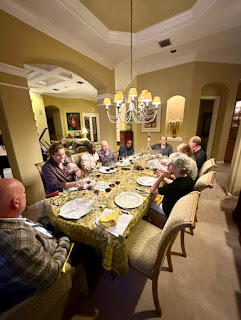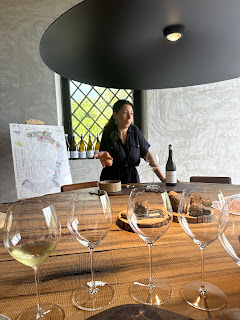Tenute di Nuna is a Sant'Alfio-based winery operated by Marina Novello Trantino and her partner, the lawyer (and self-taught agronomist) Fabio Percola. The winery currently owns 5 ha of land in Sant'Alfio and 1 ha in the neighboring comune of Milo. Four of the Sant'Alfo hectares are planted to Carricante (Guyot-trained) while the Milo Carricante vines are Alberello-trained.
 |
| Fabio in the vineyard |
A fair amount of work was required to get the vineyard ready for grape-growing. For example, the land below the terraces had to be built up. The first 75 m had to be filled in so the soil is very deep. The final section, on the other hand, has soil that is only 1 m deep. This section has less water so the plants suffer from dehydration (In the early days, this section had to be irrigated). The yields from the deep-soil section are higher than from the thinner-soil area.
The Sant'Alfio vineyard (840 m asl) was planted in 2000 and the first grapes harvested in 2015. The Milo plot (900 m asl) was purchased in 2017 and the first Etna Bianco Superiore was produced therefrom in 2020. Both vineyards are farmed organically.
While the Sant'Alfio property is being renovated, the Tenute di Nuna wines are produced at Cantina di Nessuno in Trecastagni. Nuna produces two commercial labels (Etna Bianco and Etna Bianco Superiore -- both 100% Carricante) and an experimental Spumante. A young Sicilian winemaker named Benedetto Alessandro assists in the process.
The base wine for the Spumante is sourced from Cantina di Nessuno and includes 15% Nerello Mascalese. The wine does not meet Etna DOC requirements. It will eventually be sold to visiting winelovers rather than being placed into distribution.
The 2020 Spumante that we tasted exhibited breadiness, salinity, and high acidity. It has potential but either needs to be later-picked or have higher sugar levels at dosage in order to offset current acid levels. It should be noted that Cantina di Nessuno picks the grapes for its base wines earlier than it does for its dry wines.
 |
| Brandon and Fabio tasting the Spumante |
We did not taste any of the DOC wines during our visit but tasted both during VinoMilo events during its two-week cycle. The 2020 Nuna Etna Bianco was tasted at the "In The Steps of Mario Soldati" event and showed green herbs, mint, salinity, and a savory character. On the palate, golden apple, lime, and salinity along with an almond-pit bitterness on the finish.
The 2021 Nuna Etna Bianco Superiore was tasted at the Etna Bianco Superiore event and was the third wine in the third of four flights. The hurried nature of the event did not provide the opportunity for a full-on assessment of the product. My notes speak of sweet white fruit and "perfumed on the palate." In my ongoing survey of the top Etna Bianco Superiores, however, one of my respondents has characterized this wine as one of the top four Superiores with "freshness, elegance, minerality, and big structure in the mouth ..."
*****************************************************************************************************
Tenute di Nuna is a small, young entity that is led by an enterprising couple who have strung together the pieces of a puzzle to make quality wine while building towards a more integrated, comprehensive outcome. They focused initially on property acquisition and development and then utilized available resources (outsourced production, local oenologist, in-house agronomic expertise, non-estate base wines) to develop quality products. This resourcefulness will be further manifested in the estate and its products with the passage of time.





















































